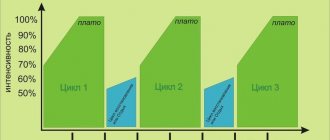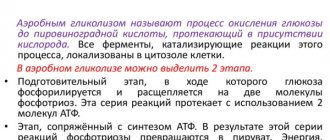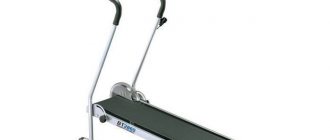In this article we will talk about the importance of using cycling and periodization in bodybuilding in order to break out of stagnation and improve athletic performance.
Sooner or later, any athlete who regularly engages in strength sports comes to a point when athletic performance stops growing. A so-called plateau or stagnation occurs in the training process. This happens when training is monotonous for a long time and does not change, the same exercises are used, the same repetition series, the same number of repetitions, etc. The human body adapts to monotony and stops responding to stress.
In order for the body to respond to training again, you should resort to tricks and apply cycling and periodization of loads. These load regulation techniques were first developed in weightlifting and later transferred to powerlifting and bodybuilding.
Load cycling: macroperiodization
The first thing to do is to distribute the training cycle into phases. If we proceed from a training program with a fixed number of repetitions in each exercise (only the weight changes - upward), then the loads in the cycle are distributed approximately as shown below. The same scheme applies to the program, where not only the weight of the bar increases, but also the number of repetitions; only in this case you increase the weight of the bar much less often, but each time you add more weight to it. In between these increases, you increase the number of repetitions.
1) Preparatory phase
During the first phase of the training cycle, following a rest period of 7-10 days, you work with weights that are 10-20% less than what you have already mastered (this does not mean your maximum working weight, but the one you can handle). work in the range of 3-4 sets of 8 repetitions).
At this stage, the emphasis is not on the maximum number of repetitions, but on developing the ideal exercise technique . In addition, it is an excellent psychological relief.
And no matter how much people in the gym show off their weights, fans of monotonously heavy training usually do not know the correct exercise technique. And if the technique is incorrect, then such “achievements” are worthless.
It’s better to make 10 times less weight than to struggle like the characters in this video:
As the intensity of the load increases, the training volumes will gradually decrease, i.e. you'll do fewer working sets, fewer exercises, and possibly workout less frequently.
The preparatory phase lasts 3-4 weeks. This phase is needed so that you can slowly “accelerate”, relax and improve your technique. You should follow a linear progression of weights: 80% of working weight, 85% of working weight, 90% of working weight, 100% of working weight.
2) Second phase
Goal: get to your highest weight in the past. As always, your progress will be measured by increasing the working weight of the barbell. If you cannot increase the weight, reduce your training volumes - reduce the number of sets and/or exercises. Perhaps exercise less often. Lower volumes at higher intensity, along with adequate recovery between workouts, are usually guaranteed to provide improved results.
At an early stage of the cycle, you sometimes discover that one of the exercises (or maybe more than one) is worse for you than the others - the weight does not increase. In this case, reduce the weight of the barbell in this exercise (or exercises) so that the exercise becomes equal in terms of “difficulty” to other exercises in the complex.
The training will become harder, but the progress will be slow and gradual. No need to immediately jump to your maximum working weight! Get there gradually .
The second phase lasts 3-4 weeks. You should follow a linear progression of weights up to your maximum working weight (1 rep max): 80% of your maximum working weight, 85% of your maximum working weight, 90% of your maximum working weight, 100% of your maximum working weight.
3) Growth phase
This is the most important phase of any cycle, and it is for this that you prepared in the previous stages. Good preparation will help you stretch it out as long as possible and get the most out of it. If, within this cycle, you increase in each of the basic exercises, this means that you generally increase muscle mass with proper nutrition, of course. These are the exercises you should focus on throughout the intensive phase of the cycle.
If you want to build as much muscle mass as possible, then accessory exercises should not interfere with the growth of your results in the main exercises. Ideally, you should increase evenly in all exercises until the end of the cycle. In practice, in order to achieve the maximum in the basic exercises, you sometimes have to reduce some of the auxiliary exercises towards the end of the cycle or perform them less often.
Again, ideally, you should not exclude any exercise from the program until you have improved in it compared to the previous cycle. But sometimes it is necessary to get rid of auxiliary exercises at an earlier stage if they interfere with progress in the main exercises. Moreover, if your responsiveness is really bad, you may not want to include assistance exercises in your program even at the very beginning of the cycle - at least not at first.
Let's say you are tightly stuck in one basic exercise. This in itself is not a reason to interrupt the cycle. You have three options: either simply maintain the achieved level in this exercise, or throw it out of the program, or replace it with a similar one. At the same time, continue the cycle to get the most out of other core exercises. Stop the cycle only if you get stuck in the vast majority of movements.
conclusions
Block periodization cannot be called a universal method. And it’s not even about sets - repeated schemes, specific exercises or personal preferences. Block periodization is an organization scheme that classifies training from general to special. To successfully use this system, the lifter must be able to thoughtfully incorporate specific exercises into blocks that follow the principles of general, general-specific, and specific training.
Once a lifter understands this planning format, he will be able to successfully use the qualities developed in the early stages to improve his performance in the competitive squat, press, and deadlift. I hope this article got you thinking and cleared up any misunderstandings about block periodization.
With us you can.
A Practical Guide to Using Block Periodization in Powerlifting. Author: Gabrielle Naspinski.
Loop example
The main criterion for the duration of the macro cycle is your well-being . Under no circumstances should you force your body! Otherwise, you will need too much time to recover before the next cycle.
So, the training cycle can be divided into four phases:
• Start with three to four “easy” weeks. But don't relax, give yourself a decent workout. During this period, you should increase the weights in each exercise from 85-90% of those previously mastered to 95%.
• Then there are several weeks of slowly building up to your previous best results.
• Next comes the growth phase - the first few weeks of mastering new scales. If you feel that the load is too much for you, reduce the number of sets, and if this does not help, feel free to cross off a couple of auxiliary exercises from the list, or even all of them.
• Try to extend the growth phase as long as possible. If necessary, sacrifice accessory exercises to progress in the basic ones. 0.5-1 kg per week to each of the basic exercises . Increase the weight on your secondary exercises, too, if you're still doing them.
VERY IMPORTANT: you cannot come to training and immediately start training with your maximum weight, you need to reach it during warm-up according to the pyramid principle: for example, 20 kg -30-40-50-60-70, etc. There are many options, the essence is the same: we warm up efficiently and don’t pretend!
What it looks like in practice:
• Workout 1: 40% of work weight • Workout 2: 60% of work weight • Workout 3: 70% of work weight • Workout 4: 80% of work weight • Workout 5: 85% of work weight • Workout 6: 90 % of working weight • Workout 7: 95% of working weight • Workout 8: 100% of working weight (our old maximum) • Workout 9: 102.5% of working weight • Workout 10: 105% of working weight • Workout 11: 107.5 % of working weight • Workout 12: 110% of working weight • Workout 13: 112.5% of working weight
The number of rest days between workouts varies depending on the severity of the load. When the load is 40%-60%, you can train the muscle group more often (for example, twice a week). But as the load increases, the number of rest days also increases.
We cannot write you the exact weight on the training apparatus because we do not know your maximum (and ideally it is constantly growing) . Take the time to take a calculator, a training diary and a pen in order to write down your training weights for training for several months in advance. The easiest way to do this is using a table. At the top (horizontally) write the training number or the date it will take place. And on the left (vertical) write a list of exercises. After that, fill in the cells with numbers indicating what weight you will work with. Learn to plan your achievements. After all, this is very important to be able to do not only in the gym.
Transformative mesocycle
It is during this mesocycle that many athletes have questions about planning. To fill this gap, I have added several working diagrams to the article.
The percentages set out below should be treated as a guide. Minor adjustments are acceptable. The only thing that can cause confusion on the scale is equipment. It is very important to take your actual training maximum as a basis. When performing certain movements, you should take into account the technique, and base the seto - repeated y pattern - on this. Also, count the percentages of the maximum in a special exercise, do not even think about taking them from a competitive exercise, for example, a squat. Otherwise, don't be surprised why you were suddenly crushed by a barbell.
First example: Transformational mesocycle (4 training days per week)
Day 1: Press
T-shirt press 75 – 90% 4 – 12 reps total
Board press (with or without a shirt) 75 – 85% or based on Subjective Load Rating (SRR) 6 – 15 reps total
Horizontal rows 30 – 40 repetitions total
Stretching a rubber band in front of you with straight bent arms, 30–40 repetitions in total
Day 2: Cravings
Competition Rows 75 – 90% 4 – 12 reps total
Squat with safety squat bar on a low box 75 – 85% or based on ROP 6 – 15 reps total
Romanian deadlift with snatch grip 3 – 4 sets 6 – 10 reps *based on RPT
Abs, upper back, hamstrings 2 – 3 sets for each muscle group 12 – 20 repetitions
Day 3: Bench
T-shirt press 75 – 90% 4 – 12 reps total
Close-grip incline press 3 – 5 sets 6 – 10 reps *based on ROP
Vertical row 30 – 40 repetitions total
Raises arms in front of you 30 – 40 repetitions total
Day 4: Squat
Squat in briefs or suit without straps, or both 75 – 90% 4 – 12 reps total
Rows in the rack (= from the plinths) 75 – 85% or based on RNC 6 – 15 repetitions total
Narrow stance TA style squat 3 – 4 sets 6 – 10 reps *based on ROP
Abs, upper back, lower back 2 – 3 sets for each muscle group 12 – 20 repetitions
This is the basic split for the transformative mesocycle. Everything given above is suggested for athletes performing in equipment. If you compete in the raw division, everything remains the same, just done without equipment. Percentages and sets - repeated patterns remain unchanged.
Training becomes more narrowly focused, because either competitive movements or their variants are taken. On bench press days, horizontal and vertical rows are present, only in a reduced volume, compared to the accumulation block. On squat days, the main movement is the competition squat, followed by a deadlift specific (SP) exercise, and then a general squat specific (OC) exercise at a lower intensity. On deadlift day, everything is the same, only in reverse - deadlift - SP - squat - OC - deadlift. On these two days, general exercises should be done in a “circular” style to maintain the level of general physical fitness. If necessary, this part is removed, depending on how you feel. The intensity of circular work is low.
This scheme has its pros and cons. Pros: such a volume of special and general-special work will better “translate” into results in competitive movements. Cons: training in this style takes a lot of time. Using basic, multi-joint exercises, you have to pay more attention to technique, and, as a result, take longer rest breaks between sets. In addition, a 4-day split is not suitable for everyone, due to the workweek schedule. For some, time for recovery will not be enough. Others may need more general exercises to target a specific area due to an old injury, weak spot, etc. P.
Here is another example of a 4 day split
The press days remain the same, but there are slight changes made to the squat and deadlift days.
Day 1: Press
T-shirt press 75 – 90% 4 – 12 reps total
Board press (with or without a shirt) 75 – 85% or based on Subjective Load Rating (SRR) 6 – 15 reps total
Horizontal rows 30 – 40 repetitions total
Stretching a rubber band in front of you with straight bent arms, 30–40 repetitions in total
Day 2: Cravings
Competition Rows 75 – 90% 4 – 12 reps total
Squat with safety squat bar on a low box 75 – 85% or based on ROP 6 – 15 reps total
GHR (with weights or resistance bands) 32 – 50 reps total
Upper back – optional
Press
Day 3: Bench
T-shirt press 75 – 90% 4 – 12 reps total
Close-grip incline press 3 – 5 sets 6 – 10 reps *based on ROP
Vertical row 30 – 40 repetitions total
Raises arms in front of you 30 – 40 repetitions total
Day 4: Squat
Squat in briefs or overalls without straps, or both 75 – 90% 4 – 12 repetitions total
Rows in the rack (= from the plinths) 75 – 85% or based on RNC 6 – 15 repetitions total
Reverse hyperextensions 3 – 5 sets 8 – 12 reps
Press
As you may have noticed, in this version of the split there are fewer general and special exercises. Training will not be as time-consuming, and those who find it difficult to remove such a variable as “real life” from the equation will find it a little easier to recover. In addition, it is permissible to add general exercises to work on weak points.
Some of you may have various other obligations in addition to work. Since the option of dismissal and divorce does not suit you, you can try the scheme given below. The scheme will work if higher powers (family, work, etc.) allow you to train 3 days a week, without limiting your time. This option is also suitable for those who are recovering well and want to add special and general exercises. A bonus to this scheme is the opportunity to work on the big three special and general special exercises.
Third example: Transformative mesocycle (3 training days per week)
Day 1: Press – Deadlift – Squat
T-shirt press 75 – 90% 4 – 12 reps total
Thrusts in the frame (= from plinths) 75 – 85% or based on RNC 6 – 15 repetitions in total
Narrow stance TA style squat 3 – 4 sets 6 – 10 reps *based on ROP
A few sets of lats, abs, or whatever you have time for.
Day 2: Deadlift – Squat – Press
Competition Rack Row 75 – 90% 4 – 12 reps total
Squat with safety squat bar on a low box 75 – 85% or based on ROP 6 – 15 reps total
Close-grip incline press 3 – 5 sets 6 – 10 reps *based on ROP
A few sets of hamstrings, abs, or whatever you have time for.
Day 3: Squat – Press – Deadlift
Squat in briefs or overalls without straps, or both 75 – 90% 4 – 12 repetitions total
Board press (with or without a shirt) 75 – 85 or based on ROP 6 – 15 reps total
Romanian deadlift with snatch grip 3 – 4 sets 6 – 10 reps *based on RPT
A few sets on the lower back, abs, or whatever you have time for.
If you only have the opportunity to train 3 days a week for a limited time, the scheme outlined below will be the optimal solution. It will not contain so many general and special exercises, but the basis will be as in the diagram above.
Fourth example: Transformative mesocycle (3 training days per week)
Day 1: Press – Deadlift
T-shirt press 75 – 90% 4 – 12 reps total
Thrusts in the frame (= from plinths) 75 – 85% or based on RNC 6 – 15 repetitions in total
Horizontal row 3 sets 10 – 15 reps
Reverse hyperextensions 3 sets 10 – 15 reps
Day 2: Deadlift - Squat
Competition Rack Row 75 – 90% 4 – 12 reps total
Squat with safety squat bar on a low box 75 – 85% or based on ROP 6 – 15 reps total
GHR 30 – 50 repetitions total
Press
Day 3: Squat – Press
Squat in briefs or overalls without straps, or both 75 – 90% 4 – 12 repetitions total
Board press (with or without a shirt) 75 – 85% or based on Subjective Load Rating (SRR) 6 – 15 reps total
Goodmoning with rubber bands 40 – 60 repetitions total
Dumbbell press 30 – 50 repetitions total
And finally, another version of the program for the transformative mesocycle. I know that many lifters like to use resistance adjustments in their training, especially those who compete in multi-layer equipment.
I will outline my position on adjusting resistance: I do not consider it necessary to use it in special exercises, since one of the goals of such exercises is to improve technique. Rubber bands change the dynamics of movement. True, the same cannot be said about chains. Of course, they can be used in special exercises, but, in most cases, it is better to leave them for general special exercises.
Below is an example of using bands and chains in general specific exercises within a 4-day split. The reason I use SRR (Subjective Rating of Load) is because it's pretty hard to give a person percentages when you don't know how exhausting the main exercise is for them. And with the use of drag adjustment, it becomes even more difficult to tell.
Day 1: Press
T-shirt press 75 – 90% 4 – 12 reps total
Board Press with Resistance Bands Based on Subjective Load Rating (SRR) 6 – 15 reps total
Horizontal rows 30 – 40 repetitions total
Stretching a rubber band in front of you with straight bent arms, 30–40 repetitions in total
Day 2: Cravings
Competition Rows 75 – 90% 4 – 12 reps total
Box Squat with Bands and Chains Based on RRP 6 – 15 reps total
GHR (with weights or resistance bands) 32 – 50 reps total
Upper back – optional
Press
Day 3: Bench
T-shirt press 75 – 90% 4 – 12 reps total
Close-grip incline press 3 – 5 sets 6 – 10 reps *based on ROP
Vertical row 30 – 40 repetitions total
Raises arms in front of you 30 – 40 repetitions total
Day 4: Squat
Squat in briefs or overalls without straps, or both 75 – 90% 4 – 12 repetitions total
Rows in the frame (= from the plinths) with rubber bands Based on the RNC 6 – 15 repetitions in total
Reverse hyperextensions 3 – 5 sets 8 – 12 reps
Press
Micro periodization
However, we should not hope that progress will continue indefinitely. Our body is not iron or even rubber, so without farming, progress always slows down and stops over time. In order to push this point back as far as possible, we will start using another trick called microperiodization .
Let’s say that after “overclocking” from 40%, you broke through the previous “ceiling of achievements” (100%) and within a month or two reached 110% of your previous weight. This is where it’s time to use microperiodization. To do this, we will set an easy week after the usual “hard” week.
Those. our diagram will look like this:
• Hard week 100% • Easy week 40% • Hard week 100% • Easy week 40% • Hard week 100% • Easy week 40%
You can choose a more complex scheme: light – medium – heavy:
• Workout 1: 40% of the maximum working weight (hereinafter we mean your maximum working weight, i.e. the one that you can perform 1 time) • Workout 2: 60% of the working weight • Workout 3: 80% of working weight • Workout 4: 100% of working weight
• Workout 5: 50% of work weight • Workout 6: 70% of work weight • Workout 7: 90% of work weight • Workout 8: 102.5% of work weight, etc.
In short, come up with it as you please and conveniently, you get the point: easy workouts are replaced by hard ones.
The main rule : easy training should be really easy, and not so that your eyes pop out of your head. Reduce the working weights as mentioned (to 40%) and work without failure.
Load cycling is one of the well-known methods to overcome the adaptation problem . There are different schemes, but the meaning is the same: periodic alternation of loads of different sizes makes it possible to restore sensitivity. Like with coffee: if it doesn’t invigorate you, reduce the dose for a while. In addition to restoring sensitivity, load cycling also serves as an excellent prevention of under-recovery and injury.
Errors in determining the starting load
If you incorrectly determined the starting weights in one or more exercises, correct the mistakes in the next workout. For example, squats ( The Ideal Squat for a Tight Butt ) may be harder than other exercises. It's okay - the next time you squat, reduce the weight of the barbell by 5-10%.
Errors in using loops:
1) Don't overexert yourself during easy workouts and don't demand too much from your body in the second half of the cycle. 2) Do not reduce the number of easy workouts, trying to quickly move on to a more difficult stage. 3) Don't try to do as many reps as possible with the light weights you start with. If you go all out with light weights, you will violate the basic principle of cycling: easy - hard.
Everyone must choose the most suitable cycle for themselves; here you need to think and experiment. Usually one of these points causes “insurmountable” problems: either you don’t want to think - “this is not nuclear physics”, or experiment - “I don’t have time, I want to pump myself up for the summer/new year/vernal equinox.”
To begin with, it is best to split your workouts into hard and light in equal proportions - 50/50. Everything else is selected individually . If you start tearing veins at an early stage of the cycle, then you will exhaust yourself at the start.
Cycling training frequency
In addition to changing the magnitude of the load, you can also practice changing the frequency of the loads. Thus, we will try to resolve the contradiction between the advantages of infrequent exercise (when sensitivity has time to recover) and frequent exercise (“spurring” muscles to grow at a constantly high rate of protein synthesis after the previous load).
The recommended range for training one muscle group is from 1 to 3 times a week (How many times a week should you go to the gym to train? The best time of day for training).
Macrocycle of 3 microcycles:
1st cycle : 3 weeks the muscle is trained 3 times a week (for example, full body training, more details in the article “Myth from the 2000s: training for mass and relief” ) + 4th week - recovery (moderate loads);
2nd cycle : 3 weeks - 2 times a week or 3 times every 2 weeks (for example, top/bottom) + 4th week - recovery;
3rd cycle : 3 weeks - 1 time per week (for example, splits) + 4th week - recovery.
Then the macrocycle is repeated: 3, 2, 1 time per week.
How I learned about block periodization
I first heard about block periodization when I interned with Buddy Morris and James Smith at the University of Pittsburgh. James told me a little about this system, I was interested, but overall I was skeptical because it was nothing like what I was doing. Moreover, I did not understand the terminology he used and how to apply it. During this period, I was still using a similar training regimen to Westside, and did not want to change anything, since I had received good gains from it in the past.
I continued to train using Westside principles, but I was often injured. Also, the results were very inconsistent because I rarely did competition movements. As a result, after a series of injuries and competitive failures, I decided to take a little break from powerlifting. After moving to Washington, I met Carlos Oseguieda, manager of the Central Virginia Athletic and Barbell Club. Carlos said that he trains according to the principles of block periodization and is making good progress.
This time, I decided to understand better and purchased books by Vladimir Issurin: Block Periodization: A Breakthrough in Sports Training and Principles and Basics of Advanced Athletic Training. These books revealed to me the principles of block periodization, so for the next year, through trial and error, I adjusted the training plan to suit myself. Working out according to this system, I added 86 kg to my total and fulfilled the elite standard in cat. up to 110 kg.
Rate of progress
All talk about 10 kg of muscle mass, allegedly added in one and a half to two months of hard training without steroids or weight loss, belongs to the genre of unscientific fiction. In a week, the maximum weight (meaning: lean muscle mass) that a person can gain ranges from approximately 0.5 to 1 kilograms. Yes, unfortunately, it’s not possible to build up huge muscles in a week or a month. It follows from this that the maximum that a person can gain in one month is 4 - 5 kilograms of lean muscle.
Even purely hypothetically, it is impossible to gain 10-25 kg of muscle in a month; sometimes this is unrealistic even after years of training.
But even such growth rates can only be maintained sporadically . Life will not allow you to exist without family, work, friends, etc. In reality, an amateur can only add mass and strength using the proven method of slow but inexorable progress.
Powerlifting - what is it, its differences
Powerlifting or powerlifting is a sport. Athletes competing in powerlifting competitions set their main goal to overcome the resistance of the maximum weight for the athlete. Raising maximum weights occurs in three exercises; the competitive results of weightlifters of the same weight category are compared with each other and assessed in total based on the weights taken in all 3 exercises.
Bodybuilding is aimed primarily at developing muscle mass, relief and body proportions, and does not require high functionality, while powerlifting is focused on constantly increasing strength results.
Powerlifters do not need to develop endurance, unlike track and field athletes, as well as athletes competing in the CrossFit discipline.
What to do if you miss a workout?
If, upon arriving at the gym, you find that you are having a “bad” day today, do not force yourself to do all the required exercises, no matter what stage of the cycle you are at. If you don't feel well before your workout, postpone it for a day or two. Consider it an extra day of rest (it's a good thing) and pick up where you left off.
If you have already started working out and realize that you are out of shape, reduce the weight of the apparatus by half and do a few repetitions less than the planned number. Don’t try to deceive your body - it won’t work anyway . Don’t worry that you’re “off schedule”: at the next workout, do what you planned for the “bad” day, and thus resume moving through the cycle.
How to Avoid Injuries in Powerlifting
When starting powerlifting classes, do not try to learn the technique of performing heavy, complex movements on your own; seek help from a coach or an experienced athlete; this will reduce your time and also reduce the risk of injury tenfold.
With the correct movement technique, the likelihood of injury (sprains, bruises, as well as ruptures of muscles, ligaments and tendons) is minimized.
Strength increases gradually, do not chase the weights on the bar, do everything according to plan and in a timely manner.
To support your lower back and spine when deadlifting and squatting, use a weightlifting belt. To protect your knees, you can use elastic bandages, bandages or special knee pads.











